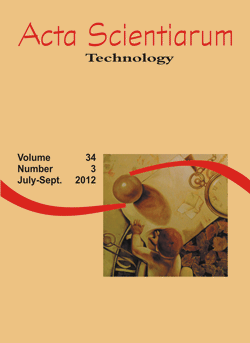<b>Electrohemical properties of carbon nanotube paste electrodes modified with redox cationic dyes</b> - doi: 10.4025/actascitechnol.v34i3.15250
DOI:
https://doi.org/10.4025/actascitechnol.v34i3.15250Palavras-chave:
carbon nanotubes, electron mediator, cationic dyes, cyclic voltammetryResumo
The present work describes the electrochemical behavior of methylene blue and toluidine blue as electron mediators adsorbed in the multiwall carbon nanotubes paste. Based on midpoint potential and separation of cathodic and anodic peaks (ΔE), it was not observed interaction of different eletrolytes with the cationic dyes by an ion exchange reaction and, as a consequence, absence of leaching of cationic dyes to the solution phase. The kinetics of electron transfer on the surface electrode was not sufficiently fast showing a fairly resistence of carbon nanotube paste modified with the mediators. The midpoint potential and ΔE also were insentive to the pH range (4-8), confirming the protective effect of carbon nanotubes matrix, owing to strong interaction of between the latter and the nitrogen of nitrogen of cationic dyes with carbon nanotube matrix, minimizing the proton interaction under cationic dye. This result is very important for sensor/biosensor preparation, because the eletrooxidation behavior of the analyte will be only affected by its formal potencial shifting. Carbon nanotubes proved to be an efficient solid matrix for the adsorption of mediator electron in comparison to the electrochemical behavior of free cationic dyes in solution phase.
Â
Downloads
Downloads
Publicado
Como Citar
Edição
Seção
Licença
DECLARAÇíO DE ORIGINALIDADE E DIREITOS AUTORAIS
Declaro que o presente artigo é original, não tendo sido submetido í publicação em qualquer outro periódico nacional ou internacional, quer seja em parte ou em sua totalidade.
Os direitos autorais pertencem exclusivamente aos autores. Os direitos de licenciamento utilizados pelo periódico é a licença Creative Commons Attribution 4.0 (CC BY 4.0): são permitidos o compartilhamento (cópia e distribuição do material em qualqer meio ou formato) e adaptação (remix, transformação e criação de material a partir do conteúdo assim licenciado para quaisquer fins, inclusive comerciais.
Recomenda-se a leitura desse link para maiores informações sobre o tema: fornecimento de créditos e referências de forma correta, entre outros detalhes cruciais para uso adequado do material licenciado.



















